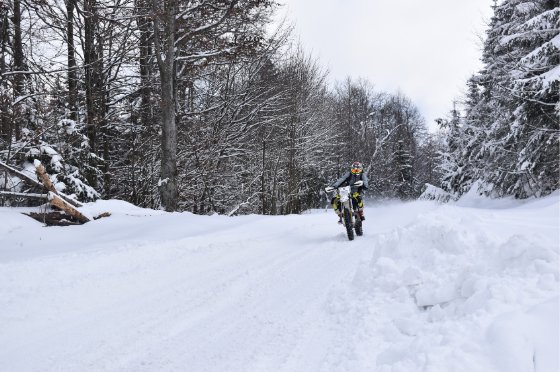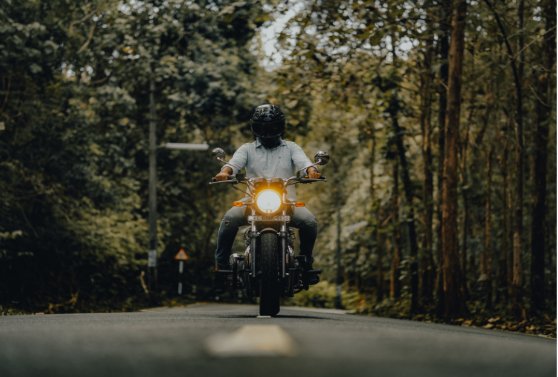When you think about riding your motorcycle, you probably picture enjoying a nice ride in good weather. But sometimes, the weather can surprise you and become less pleasant. In those situations, riders need to be ready to handle changes that could affect their safety on the road.
Different seasons, like spring, summer, fall, and winter, bring their own challenges for motorcyclists. Here are some easy-to-understand tips for each season to help you ride safely:
Spring Riding
After the grip of winter, the arrival of spring is often a welcome relief for riders. However, despite the warmer temperatures, spring can bring its fair share of rainy days, presenting challenges for motorcyclists who need to navigate slippery roads and prepare for potentially wet rides.

One of the trickiest times to ride in the rain is during the initial moments of a downpour, as explained by experts. During this period, rainwater fills the road’s imperfections, and any residual oil can rise to the surface, creating a highly slippery surface. In such situations, it’s advisable to consider a brief stop and wait for the rain to subside, a recommendation echoed by motorcycle safety organizations.
If riding through the rain is unavoidable, exercise caution by reducing your speed and increasing the following distance between you and the vehicle in front. Wet roads require more distance to come to a stop safely. Maintain smooth and gentle maneuvers, avoiding sudden braking, rapid acceleration, or abrupt turns, as these actions can further reduce traction on the rain-soaked road. Additionally, be wary of standing water, as it conceals potential hazards like potholes underneath.
When it comes to your riding gear, consider investing in a quality rainsuit that covers your boots and gloves for protection. Enhancing visibility in rainy conditions is also crucial, and you can achieve this by incorporating reflective accessories into your attire, as suggested by experts in motorcycle safety.
Fall Riding
As summer transitions into autumn, the air becomes crisper, and the landscape transforms with the falling leaves. Before the arrival of snow and ice, motorcyclists should prepare for wet roads and the challenge of navigating slippery leaves on their beloved routes.

Riding your motorcycle during the autumn season necessitates readiness for fluctuating temperatures and occasional rain showers. Experts recommend versatile gear, including jackets with removable linings and helmets with adjustable vents, allowing you to adapt to varying temperatures throughout the day. It’s also advisable to carry rain gear in case of unexpected showers.
Fallen leaves can obscure the road’s surface and pose hidden hazards, such as covering potholes or road imperfections. Wet leaves further reduce your motorcycle’s traction, so caution is vital when riding over them.
Additionally, autumn is a time when wildlife activity increases. Animals, like deer, may become more active as they migrate or search for food before winter. Dawn and dusk are peak times for wildlife encounters, so staying vigilant and exercising extra caution is crucial for a safe ride.
Summer Riding
As the summer temperatures soar, it may be tempting to ditch layers and enjoy the warmth while riding your motorcycle. However, riding without precautions in hot weather, especially when it exceeds 70 degrees Fahrenheit, can pose risks, as summer presents its unique challenges.

Despite the heat, it’s essential to prioritize protective clothing and gear. During extended rides in hot, sunny climates, protecting yourself from sunburn and dehydration becomes vital. While wearing shorts and a T-shirt may seem appealing, experts advise opting for long sleeves and pants to prevent dehydration. Wearing a well-ventilated jacket can facilitate airflow, promoting natural cooling through perspiration evaporation.
For those braving scorching weather, there are specialized gear options designed for hot conditions. These items utilize lightweight materials and improved ventilation to keep you comfortable. Whether it’s jackets, helmets, or boots, you can find gear tailored to warm weather. Additionally, consider using base layers designed for hot weather to efficiently wick away moisture, ensuring you stay cool and comfortable throughout your ride.
Winter Riding
For even the most dedicated motorcycle enthusiasts, the idea of stowing their bike during the coldest months is a consideration. This is because winter ushers in challenging conditions such as strong winds, snow, ice, and freezing temperatures, which are generally less than ideal for motorcycle riding.

Before embarking on a winter ride, it’s essential to inspect your tires. Your owner’s manual will provide guidance on the required tread depth for safe driving. A quick “penny test” can also help you assess tire tread. Hold a penny with Abraham Lincoln’s head visible and place it into one of the tire tread grooves. If any part of Lincoln’s head is obscured by the tread, it’s likely safe. However, if you can see above Lincoln’s head, it’s time for new tires. Additionally, check your tires for uneven wear, bulges, cracks, or any foreign objects embedded in them.
Proper tire inflation is crucial in cold weather, as the cold can cause tire pressure to drop. Since cold temperatures make tire rubber harder, it’s advisable to ease into your ride to allow the tires to warm up and provide better traction.
Hypothermia due to severe wind chill is a real concern when riding a motorcycle in winter. The speed at which you travel can intensify heat loss from your body. Therefore, staying warm and protected becomes paramount. Depending on the temperature, consider wearing thermal underwear, warm socks, glove liners, and balaclavas as base layers. To keep extremities warm, think about using chemical heat packs in gloves and boots. You can even equip your bike with grip, seat, and foot warmers for added comfort. Finally, a well-insulated helmet with a full face mask can help shield you from the cold.
Regardless of the season, thorough preparation and the right equipment are essential for safely enjoying motorcycle rides throughout the year.
Insurance Considerations for Motorcyclists
While mastering the art of safe motorcycling in different seasons is essential, it’s equally vital to address the subject of insurance. Motorcycle insurance is a critical aspect of responsible riding, and it can provide peace of mind in case of unexpected incidents on the road.
Motorcycle insurance typically offers coverage for bodily injury liability, property damage liability, medical payments, and uninsured/underinsured motorist coverage. However, the specific coverage and requirements may vary depending on your location and insurer.
Here are some key insurance considerations for motorcyclists:
- Minimum Coverage Requirements: Be aware of your state’s minimum insurance coverage requirements. Ensure that your policy meets or exceeds these minimums to comply with legal obligations.
- Liability Coverage: Liability coverage is essential as it helps protect you financially if you are found at fault in an accident that causes injury to others or damage to their property. Consider purchasing higher liability limits for added protection.
- Medical Coverage: This coverage can help pay for medical expenses for you and your passenger in the event of an accident, regardless of fault.
- Uninsured/Underinsured Motorist Coverage: This coverage is crucial in case you are involved in an accident with a motorist who lacks insurance or has insufficient coverage. It can help cover your expenses if the at-fault party cannot.
- Comprehensive and Collision Coverage: These optional coverages can help repair or replace your motorcycle in the event of theft, vandalism, or an accident. They are particularly important for expensive or newer motorcycles.
- Safety Discounts: Some insurers offer discounts for completing motorcycle safety courses or installing anti-theft devices on your bike. Inquire about these discounts to lower your insurance costs.
- Annual Review: It’s a good practice to review your motorcycle insurance policy annually to ensure it still meets your needs. As your circumstances change, your coverage requirements may evolve.
- Claims Process: Familiarize yourself with your insurer’s claims process, including how to report an accident and what information you’ll need to provide. Being prepared can make the claims process smoother in a stressful situation.
Remember that motorcycle insurance is not just a legal requirement; it’s a valuable safeguard for you, your passengers, and your bike. Invest time in understanding your policy and selecting coverage options that align with your riding habits and needs. By doing so, you can enjoy the freedom of the open road with confidence, knowing that you’re protected in every season.
Summary
Riding a motorcycle is a thrilling experience that can be enjoyed year-round. However, each season presents its own set of challenges and considerations for motorcyclists. Whether it’s navigating wet spring roads, dealing with falling leaves in the fall, riding in the heat of summer, or braving winter’s cold, safety should always be a top priority.
By following the season-specific tips outlined in this guide, riders can enhance their safety on the road. These tips include adjusting your riding style to match the weather conditions, wearing appropriate gear, and conducting necessary maintenance checks on your motorcycle.
Remember that preparation and caution are key to enjoying motorcycle rides in all seasons. By staying informed and being mindful of the unique challenges each season brings, you can continue to experience the joy of motorcycling while prioritizing your safety. So, gear up, stay vigilant, and enjoy the ride, no matter the season.
FAQs
Do I need to adjust my riding style for each season?
Yes, it’s important to adapt your riding style based on the weather conditions of each season. For example, in rainy spring conditions, reduce your speed and increase following distance to maintain traction. In winter, ride cautiously to account for icy roads.
How to Get Motorcycle Insurance?
To get motorcycle insurance, start by researching insurance providers. You can contact agencies like the tutenagency, an exclusive agent with Allstate, for personalized assistance. If you live in Alabama or Georgia, these agencies can help you find the right motorcycle insurance coverage for your needs.
Get the right coverage for your motorcycle with tutenagency
New tutenagency customers?
Quote motorcycle insurance online or call (334) 502-5111 to insure a motorcycle.
Disclaimer: This content is for informational purposes only and should not be considered legal or financial advice. Always consult with qualified professionals in legal and financial fields before making any decisions.

